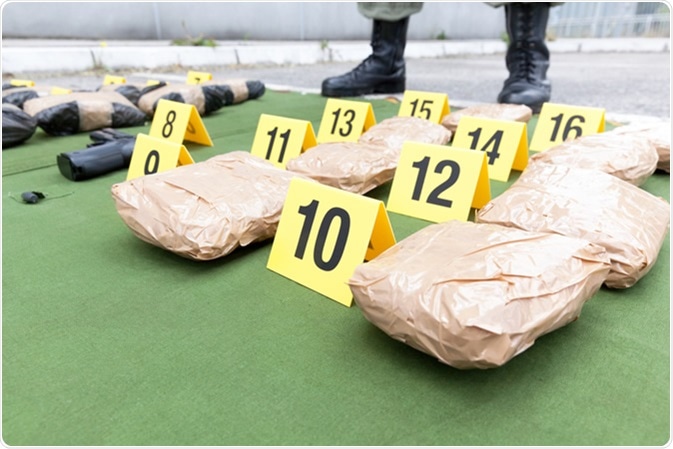Skip to:
Researchers from the Institute of Forensic Medicine at the University of Bern have developed a new method for the forensic analysis and quality control of cannabis products.
The method successfully characterized 110 cannabis samples seized by police, thereby demonstrating its ability to meet the increasing worldwide demand for fast, and effective routine cannabis potency testing in the forensic setting.
“The presented method proved to be sensitive, selective, accurate, and precise and was successfully used on herbal cannabis and hashish samples from forensic cases,” write Wolfgang Weinmann and colleagues.

Police officer standing guard over seized cannabis packages. Image Credit: Wellphoto / Shutterstock
The Increasing Need for Reliable Cannabis Analysis
Recently, the analysis of cannabis has gained new importance globally, mainly to provide quality control in the production of legalized recreational and medical cannabis, but also to help forensic analysts differentiate between illegal drug-type cannabis and legal products.
The cannabinoid D9 -Tetrahydrocannabinol (THC) is the most psychoactive cannabis constituent, inducing feelings of euphoria and relaxation, but it has also demonstrated analgesic, anti-inflammatory, and appetite stimulating properties.
However, long-term THC use has been linked to severe adverse side effects such as cognitive deficits, anxiety, psychosis and dependence. Cannabidiol (CBD), a non-psychoactive THC isomer, is another cannabinoid that demonstrates great therapeutic potential and studies also indicate that it mitigates the adverse psychological effects of THC.
Over recent decades, cannabis cultivation has favored THC-rich/CBD-poor plants that confer the greatest psychoactive effects, but the increasing interest in the therapeutic potential of CBD has been directed more towards breeding CBD-rich plants.
The ratio of the cannabinoid content largely depends on environmental and harvesting conditions. THC and CBD are biosynthesized as pharmacologically inactive carboxylic acids, D9 -tetrahydrocannabinolic acid A (THCA) and cannabidiolic acid (CBDA), respectively. The active, neutral cannabinoids form when decarboxylation occurs as the plant ages and is exposed to light or heat. The pharmacological potency of cannabis is therefore most accurately represented by the total cannabinoid content (the sum of the free cannabinoid and its respective acidic precursor).

THC molecules binding to the cannabinoid receptor. The receptor appears mainly in the nervous system and is involved in appetite, pain-sensation, mood and memory. 3d rendering - Illustration Credit: Juan Gaertner / Shutterstock
The Roll-on Effect of Cannabis Legalization
As of October 2018, Canada became the second country after Uruguay to fully legalize cannabis and as of December 2018, ten states in the US have legalized its recreational use and 33 more, including states in Australia, have legalized it for medicinal use.
This has resulted in a growing demand for cannabis potency testing and the recent emergence of multiple analytical laboratories in efforts to keep up with demands. Examples of the most widely used analytical techniques are gas chromatography combined with mass spectrometry (GC-MS) and high-performance liquid chromatography (HPLC) with UV or MS detection.
HPLC versus GC Techniques
The GC-based techniques are faster and simpler to use than HPLC. However, “HPLC offers advantages over previously reported GC-based methods as neutral and acidic cannabinoids can be quantified separately, thus allowing direct determination of the original cannabinoid profile as well as more accurate quantification of total cannabinoid contents,” writes Weinmann and team.
New HPLC Technique Provides Accurate, Reliable Results
As recently reported in the journal Forensic Science International, Weinmann and colleagues have now developed and validated a simple, reliable and sensitive HPLC with Diode-Array Detection (HPLC-DAD) method. The technique enables quantitative analysis of the major neutral and acidic cannabinoids THC, THCA, CBDA, cannabidiol and cannabinol (CBN) to determine the psychoactive and therapeutic potential of herbal cannabis and hashish.
The method was applied to 110 forensic cannabis samples seized by the Swiss police that had been submitted for routine potency testing, including 45 samples that were claimed to be legal, commercially available CBD-rich/THC-poor cannabis flowers.
The method provided a short analytical run time of 13 minutes and produced accurate, sensitive, selective and repeatable results, as confirmed through extensive validation according to ICH and AOAC guidelines.
The best results were achieved using a core-shell C8 column and gradient elution with water/acetonitrile containing 0.1% formic acid. The core-shell stationary phase provided significantly higher resolution and sensitivity, compared with conventional chromatography columns packed with fully porous particles.
Only one of the 45 flower samples marketed as CBD-rich products had a total THC content above the Swiss legal limit of 1%, indicating that the vast majority had not been labelled to hide illegal THC-rich cannabis.
Among the 110 samples, another 17 flower samples and 11 mixed samples (those containing leaves and stems without flowers) also had total THC contents that were below the Swiss legal limit.
Thirty-seven of the cannabis samples had a total THC content that was above the legal limit. While one flower sample was a mixed strain with a more even balance of total THC and total CBD, the remainder of the flowers, hashish and mixed samples were THC predominant, with very low total CBD contents.
“These results reflect trends reported in other countries towards the use of high potency cannabis with very low CBD levels,” say Weinmann and team.
Although validation was limited to the five major cannabinoids of interest, the researchers say the method might also be suitable for testing other cannabinoids and other cannabis preparations such as oils, foods, or cannabis-based medicinal extracts: “The method is broadly applicable and can be easily implemented in forensic chemistry laboratories for differentiation between drug-type cannabis and fiber hemp as well as in quality control laboratories in the legalized cannabis industry.”
Source
Weinmann, W et al. Quantitative determination of CBD and THC and their acid precursors in confiscated cannabis samples by HPLC-DAD. Forensic Science International 2019;299:142−150 Available at: https://doi.org/10.1016/j.forsciint.2019.03.046
Further Reading